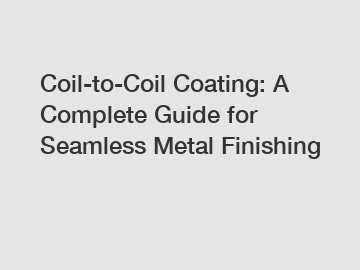Coil-to-Coil Coating: A Complete Guide for Seamless Metal Finishing
Coil-to-coil coating is a highly efficient and versatile process used in the metal finishing industry. It involves applying a protective or decorative coating to metal coils in a continuous and seamless manner. This technique is widely used in various industries such as automotive, construction, and appliances to improve the appearance, durability, and corrosion resistance of the metal.
In this complete guide, we will explore the ins and outs of coil-to-coil coating, from its benefits and applications to the different types of coatings and the process involved.
Benefits of Coil-to-Coil Coating.

One of the main advantages of coil-to-coil coating is its efficiency. By applying the coating to metal coils in a continuous process, manufacturers can save time and reduce production costs. This also results in a more consistent and uniform finish, as the coating is evenly applied to the entire surface of the coil.
In addition, coil-to-coil coating offers excellent corrosion protection, which is crucial for metal products that are exposed to harsh environmental conditions. The coating acts as a barrier against moisture, chemicals, and other corrosive agents, extending the lifespan of the metal and reducing the need for maintenance.
Furthermore, coil-to-coil coating allows for a wide range of customization options. With various colors, finishes, and textures available, manufacturers can create unique and eye-catching metal products that meet their customers' specific requirements.
Applications of Coil-to-Coil Coating.
Coil-to-coil coating is used in a wide range of industries and applications. In the automotive industry, it is commonly used to coat metal parts and components, such as body panels, trim, and bumpers, to enhance their appearance and durability. In the construction industry, coil-coated metal is used for roofing, siding, and other architectural elements due to its weather resistance and aesthetic appeal.
Coil-to-coil coating is also widely used in the appliance industry for products such as refrigerators, ovens, and washing machines. The coating provides a durable and easy-to-clean finish that enhances the overall look and performance of the appliances.
Types of Coatings.
There are several types of coatings that can be applied to metal coils through the coil-to-coil coating process. Some of the most common coatings include:
- Polyester: This type of coating is known for its excellent color retention and UV resistance, making it ideal for outdoor applications. It is also scratch-resistant and easy to clean.
- Polyvinylidene fluoride (PVDF): PVDF coatings offer superior durability and weather resistance, making them suitable for harsh environmental conditions. They are also highly resistant to chemicals and fading.
- Polyurethane: Polyurethane coatings provide a smooth and durable finish with good flexibility and impact resistance. They are commonly used in the automotive industry for their scratch resistance and color retention.
Process of Coil-to-Coil Coating.
The coil-to-coil coating process involves several steps to ensure the proper application of the coating and the desired finish. These steps include:
1. Cleaning: The metal coils are first cleaned to remove any dirt, oil, or contaminants that could affect the adhesion of the coating. This is typically done using a chemical cleaning process or mechanical methods such as brushing or blasting.
2. Pre-treatment: The metal coils are then pre-treated to improve the adhesion of the coating and enhance the corrosion protection. This can involve applying a conversion coating or primer to the surface of the metal.
3. Coating application: The coating is applied to the metal coils using a coil coating line, where the coils are unwound, coated, and then rewound in a continuous process. The coating can be applied using various methods such as roller coating, curtain coating, or spraying.
4. Curing: After the coating is applied, the metal coils are passed through a curing oven to dry and cure the coating. This process ensures that the coating bonds to the metal surface and forms a durable finish.
In conclusion, coil-to-coil coating is a versatile and efficient process that offers numerous benefits for manufacturers in various industries. From its cost and time-saving advantages to its superior corrosion protection and customization options, coil-to-coil coating is a valuable tool for achieving seamless metal finishing. By understanding the different types of coatings, applications, and the process involved, manufacturers can create high-quality metal products that meet the demands of today's market.
The company is the world’s best pre painted aluminium coil, painted aluminium coil for flashings, powder coated aluminium flashing supplier. We are your one-stop shop for all needs. Our staff are highly-specialized and will help you find the product you need.

Comments